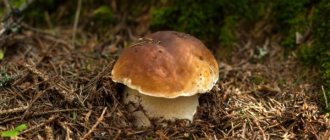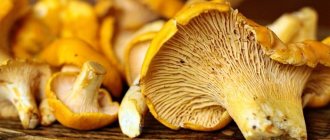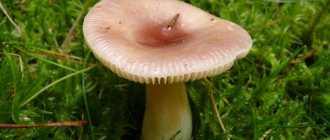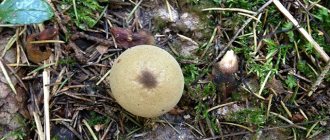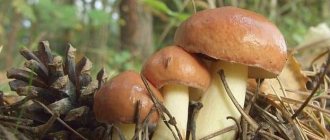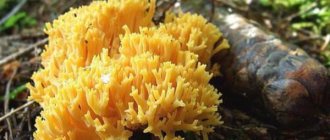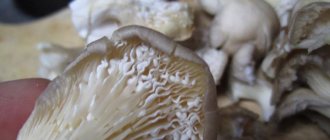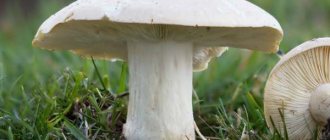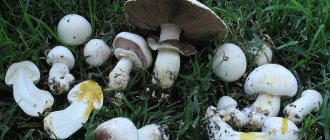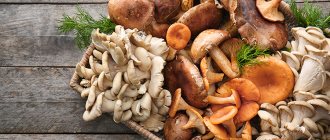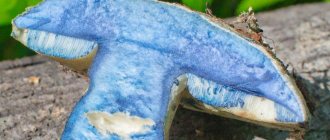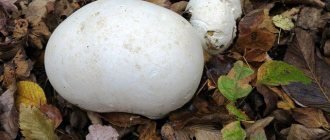This year, lovers of “quiet hunting” are incredibly happy about the large harvest of mushrooms.
However, even with such abundance, things are not so smooth. Sometimes you collect boletus in a basket, and suddenly you see that you come across wormy ones. What to do in this case: take the “loot” home? Is it even possible to eat wormy boletus, you ask? There are about 14 species of boletus mushrooms in Russia. They all love forest edges and cozy places near pine trees. In addition, boletus grow in large families, sometimes up to hundreds of individuals. After warm rains, these mushrooms appear up to 8 times a year. If you don’t rush to the forest, then after two days they grow old and deteriorate. The reason for such spoilage is the appearance of worms in the boletus.
Sometimes you can hear: if a worm eats an oil can, then it is edible. Perhaps this expression should be considered true. However, experts urge you to avoid worm-eaters to avoid poisoning.
How to get rid of worms in mushrooms
Mushrooms are a favorite delicacy not only of people, but of various insects. Many people are interested in the question of whether it is possible to eat the fruits of nature that have been spoiled by pests. If you remove the worms from the mushrooms by cleaning them well, they can be eaten.
Signs, types, reasons for the appearance of worms in mushrooms
Worms that parasitize mushrooms are larvae from the eggs of various fungus flies and mosquitoes. You can often see thick worms - click beetles or wireworms. They attack fruits regardless of type, temperature and air humidity. Only some species are not susceptible to parasites.
The larvae of flies and mosquitoes feed on the pulp, while at the same time performing an important role - transmitting spores into the soil. This contributes to a bountiful harvest. For one type of mushroom there are approximately 300 species of insects.
Important! In dry, warm weather, insects that lay eggs in fruits become more active, so collecting them at this time is not recommended.
If the fruiting body looks healthy and beautiful, but characteristic holes are found in it, this is not a reason to throw it away. The industry believes that a mushroom can be eaten if it is less than half infected with parasites. It is impossible to get poisoned from fruits with worms (unless they are poisonous or rotten). But few people want to serve food with larvae - it doesn’t look aesthetically pleasing. If the fruit is not rotten, you can give it an acceptable appearance.
Preparing mushrooms
It is better to sort mushrooms into healthy ones and wormy ones right in the forest. The wormy parts should be cut off immediately and thrown away. If they remain in the basket, the worms will move to an adjacent uninfected fruit. The wormy body can be pricked on a twig - the spores will spread in the air, and next year there will be a generous harvest in that place.
The first thing to do is to make sure that worms are actually present in the fruit. You can check this by cutting them along their entire length into two parts.
Butterfish are the most susceptible to worms. Already on the second day of regrowth, the larvae begin to eat their legs. If there is any doubt whether the honey fungus is wormy, you need to trim its stem shorter. As a rule, the passages end under the cap - such a mushroom can be eaten. There are practically no parasites in forest champignons.
Worms are almost invisible in fried or stewed fruits. But if you cook the broth, an unpleasant situation is possible, so it is advisable to strain it before serving.
How to remove by soaking
It is worth getting rid of worms in mushrooms immediately after they have been collected. To do this, they need to be cut into large pieces. First, the leg of the body is cut off, the tubular layer at the cap is removed, and the leg is divided in half. The parts are placed in cool, salted water for several hours. For 5 liters of water you need to take 1 glass of salt. Having smelled the salt, the worms will come out. This way, all the larvae will leave the fruit. All that remains to be done is to rinse them well and remove traces of the presence of pests. After this, you can start cooking.
It should be taken into account that different types of mushrooms have different densities. The peculiarity of preparing porcini mushrooms for consumption is that they should be kept in water longer than others - 3-4 hours. Milk mushrooms must lie in water for at least 24 hours. Russulas and pigs can be kept for a couple of hours.
Important! If the fruits are too spoiled, rotten or rotten, there is no point in saving them - there is nothing useful left in them.
If the worms have eaten only a small part of the body, you can simply cut off the damaged part with a knife. The main thing is that the fetus does not show signs of decomposition. Cleaned mushrooms can be fried, pickled, boiled, or pickled.
We remove pests by drying
An equally effective method is drying fruits. Under the influence of the sun, deprived of moisture, all the worms will leave their place of residence. You can dry them in two ways. Mushrooms are cut into thin slices, strung on a thread and hung. The floor is covered with newspaper or paper. After a day, all the worms will come out.
The second way to remove parasites is to cut the mushrooms into plates, place them on a metal sieve and put them in the oven. You can place a baking tray underneath. The temperature should be set to the lowest possible. Afterwards, the fruits need to be cleaned of worms, which come out halfway during drying.
Instead of an oven, you can use a stove or an electronic dryer. It is better to store dried fruits in glass jars, tightly closed with a lid. This way, their shelf life will increase to two years - the larvae will not “come to life”, and new parasites will not appear.
There is another “lazy” drying option that will get rid of the larvae. Peeled mushrooms are laid out on paper and placed on the bottom shelf of the refrigerator. After two weeks, they can be removed and stored in a dry place. If you dry the fruits this way, they will taste more delicate.
Important! It is not necessary to throw away the worms that fall out of the mushrooms. This is an excellent food for aquarium fish.
How to avoid wormy mushrooms
To reduce the likelihood of finding worms in mushrooms, you need to follow some simple tips:
- You should only buy fresh fruits. You need to start cooking immediately, before 3 hours have passed. The longer the storage period, the greater the chance that parasites will appear there.
- Mushrooms collected in the rain are especially susceptible to worms. After assembly, they must be immediately cleaned, boiled or stewed.
- If it is not possible to immediately heat the mushrooms, they should be placed in water.
- It is best to pick mushrooms at the end of summer, at the beginning of the first cold snap. This is the time of mass release of pests from the fruits. It does not last long - only 1-2 weeks, so you need to have time to visit your favorite mushroom places.
Finding the perfect mushroom, without traces of worms, is difficult. If a fruit has become home to a parasite, this is not a reason to throw it out of the basket. Mushroom pickers know: you can also make a delicious delicacy from wormy fruits.
Worms in boletus and how to get rid of them
There are about 14 species of boletus mushrooms in Russia. They all love forest edges and cozy places near pine trees. In addition, boletus grow in large families, sometimes up to hundreds of individuals. After warm rains, these mushrooms appear up to 8 times a year. If you don’t rush to the forest, then after two days they grow old and deteriorate. The reason for such spoilage is the appearance of worms in the boletus.
Sometimes you can hear: if a worm eats an oil can, then it is edible. Perhaps this expression should be considered true. However, experts urge you to avoid worm-eaters to avoid poisoning.
Why do boletus turn wormy?
Many novice mushroom pickers wonder: why do boletus mushrooms become wormy? The fact is that fruit flies and mosquitoes lay eggs on mushrooms, from which voracious larvae then emerge. Some worms live in apples, others in raspberries or strawberries, and some like butternuts. The best weather for insects is when it is dry, warm and sunny. It is at this time that the boletus begins to deteriorate. However, note that the worms themselves do not make the mushroom poisonous. In fact, the version of poisoning by “worm waste products” has no basis.
Many mushroom pickers believe that there is nothing dangerous in wormy boletus if there are not so many of them. After all, even with industrial preparations, boletus that is less than half damaged is considered suitable for consumption. But if you collect mushrooms for yourself and your family, it is better not to take wormy ones. Follow the good mushroom picking rule: less is more. Don’t rush to collect all the boletus in a row that are located in one clearing. It is better to protect your harvest in the basket from wormy mushrooms. Worms are so voracious that they can quickly destroy all the mushrooms you collect. However, if the mushroom picker followed all the precautions, but wormy boletus still ended up in the basket, what should you do?
Tips on what to do with wormy boletus
If there are wormy boletus in the basket, use the following tips. First, cut off the damaged areas. At home, process all mushrooms, especially wormy ones. How to get rid of worms in boletus? To do this, cut each mushroom into two parts and immerse them in salt water for three hours. Then all the worms will float to the surface, and the eggs will sink to the bottom. If you cut a very wormy mushroom in the forest, do not throw it on the ground. Simply prick the oil can onto the branch with the spores facing down. The hat in this position will not rot, but will gradually dry out. The spores will begin to fall out, and a new mycelium will appear nearby. And the dried mushroom will become food for forest animals in the winter.
Is it possible to eat wormy boletus?
There is no clear answer to the question of whether it is possible to eat worm-eaten boletus. These mushrooms are almost always wormy, especially if they were not collected in time. Is it possible to collect and eat wormy boletus in this case? You can answer with confidence, just don’t tell them at the table what was inside the mushroom. In fried and stewed boletus, worms are completely invisible. But if soup or mushroom noodles are prepared, the worm may emerge at the most inopportune moment. Therefore, before serving, be sure to strain the broth to avoid trouble. Take note of one rule: always collect young boletus, not overgrown ones.
How to remove worms from boletus mushrooms
Butterflies very often grow in large colonies; there can be dozens of specimens in one place. In such cases, the best way to avoid the problem of wormy mushrooms is not to take everything. If there is a sufficient number of butternuts, sorting and culling can be done right on the spot, in the forest. In this case, it is advisable to check each specimen by cutting its cap in half. If a cut reveals many worm holes, and the structure of the flesh of the fruiting body itself rather resembles old cotton wool, then there is no point in taking such a mushroom home for processing. It is better to immediately leave such rotten things in the forest.
Important! A wormy mushroom that you decide to leave in the forest can be pinned onto a branch with the stem down. In this position, it will dry out, and the ripe spores will fall out onto the ground, subsequently they will germinate and form a new mycelium. And the dried oil can will be eaten with pleasure by birds or other forest animals.
At home, before processing mushrooms, you need to check them again for worm spots. Small local lesions can simply be cut out with a knife. If several worm holes are visible on the cut of the cap, and the structure of the cap itself has not lost its density, then such mushrooms can be soaked for several hours in cold salt water. The worms will definitely leave their shelters and float to the surface, after which it will not be difficult to collect them. After this procedure, mushrooms can be processed.
The brown film covering the cap of the butter dish must be removed when using mushrooms in any way, otherwise it will give the finished dish a dark color and a bitter taste. It must be removed before soaking the mushroom in water. A wet oiler is very slippery and will be very difficult to hold in your hands. To clean the cap, it is better to wear rubber gloves, since the film that is removed from the surface of the cap contains a coloring pigment. If you do not use hand protection, your hands will turn dark brown. This paint is quite durable and does not wash off for several days.
Is it possible to eat wormy mushrooms?
The main goal of every mushroom picker’s “silent hunt” is to obtain environmentally friendly, tasty and healthy gifts of nature. But sometimes you come across wormy or poisonous mushrooms, so you need to be able to distinguish one from the other.
Is it possible to eat wormy mushrooms?
Rules for collecting mushrooms
Basic rules that will help make mushroom picking as easy and successful as possible:
- Mushrooms are collected in forests or on their edges. Find out from other mushroom pickers from your favorite gathering places. Or use a mushroom map of the area.
- The mushroom picker’s equipment should be light and comfortable, the knife should be sharp and, as they say, “fit the hand,” and a wicker basket in which there is constant air movement is suitable for transporting mushrooms.
- The best time to collect is early morning, when the sun's rays have not yet dried the dew on the caps of the fruiting bodies.
- It is better to collect those mushrooms that you are completely sure are edible. It is better to throw away those that cause even the slightest doubt, so as not to spoil the entire harvest.
- To preserve the mycelium, it is better to cut the mushrooms at the base or carefully twist them out of the ground. After this, it is advisable to sprinkle the cut (twisting) area with earth.
- Preference should be given to young mushrooms without damage. Do not rush to throw away slightly wormy mushrooms. They can be folded separately or, after removing damage, they can also be sent to the basket.
- The cut mushroom is carefully inspected and soil and debris are removed. It is preferable to put them in a basket with the caps down to save space and prevent breakage and damage. In addition, larger and heavier specimens are usually placed at the bottom of the basket, and small and light ones at the top.
- It is better to process the harvested crop immediately after returning. If stored for a long time, they deteriorate and lose their taste.
Signs of a wormy mushroom
Often during a “quiet hunt” you come across a fruiting body damaged to one degree or another by worms or other insects. To decide whether it is possible to use the wormy fungus in the future, the reasons for this process are determined.
The worms that settle in them are insect larvae that hatch from eggs laid on its surface. For the mycelium, they play an important role - they eat the fruiting body and carry spores underground, facilitating their spread.
The only edible mushroom that can never be wormy is the chanterelle. This is explained by the presence in it of a substance that is deadly to pests, which is a natural anthelmintic - quinomannose. Wet and warm weather is thought to favor the spread of worms.
It is better to cut off the affected areas
To determine whether a mushroom is wormy, carefully examine its surface and the cut site. The degree of damage is determined by the presence of irregularities, holes and clearly visible “movements” of worms. Then there are the following options:
- Only the cut area is damaged: try to remove this part up to the cap, and the rest is quite safe to cook and eat;
- a small upper part is damaged: it is carefully cut off and thrown away;
- 1-2 places of infection: the mushroom is taken with them, and at home it is treated in a special way before cooking;
- deep damage to the fungus by worms: they get rid of it, and it is better to do this by pricking it on a branch so that after drying the spores can be sprayed over a larger area.
Why does a mushroom become wormy?
First, let's find out where worms come from and on what basis they choose their victims. Do they eat all mushrooms? Why do they spoil our fun? Worms are very unpleasant creatures. It is believed that they are especially voracious in rainy summers. In fact, this observation is not entirely correct. Wormy mushrooms can be in any weather. The degree of activity of these animals does not depend on air humidity and temperature.
Mushroom worms are the larvae of various flies and mosquitoes; under the cap they find shelter and food for themselves. But unlike people, the forest beauty itself does not suffer at all from the presence of worms in its pulp. On the contrary, these larvae perform a very significant role - they facilitate the transport of spores into the soil, which subsequently increases the amount of grown crop.
Some types of mushrooms, to the delight of people, cope well with reproduction on their own and do not allow any parasites to get close to them. Sometimes you can hear the opinion that worms love all edible species, that they do not touch only those that people should not eat - poisonous mushrooms. But this statement is not true. There are species in nature that are never wormy, but they are very tasty and not at all poisonous.
Processing such specimens only involves removing stuck leaves and blades of grass, washing and cooking - boiling or frying. These include cute little foxes. They are very tasty; some experts in quiet hunting and gourmets prefer to eat them only. Being very cute, they delight the eye both in the forest in a clearing and on a plate at the table. Chanterelle is a very popular mushroom.
How to get rid of worms in mushrooms?
Many of you love mushrooms very much and willingly collect them or buy them at the market.
Amazing! Mushrooms are very tasty and healthy. However, almost every mushroom picker or mushroom lover is faced with an unpleasant problem - wormy mushrooms.
Most often, we throw away all the mushrooms on which we see even a small hole. Remember: you cannot be poisoned by worms in mushrooms (unless these mushrooms are poisonous). Therefore, the problem of wormy mushrooms is more aesthetic.
The largest restaurants in the country buy mushrooms from private owners by the hundredweight, prepare a variety of dishes from them, and no one complains. Want to know where the worms go? Are all mushrooms really examined under a microscope?
Of course not. It’s just that restaurant chefs know very well how to get rid of worms.
Let's reveal their secrets:
- Buy only fresh mushrooms. They cannot be stored for more than 3 hours. The more they are stored, the more wormy the mushrooms become.
- Mushrooms picked in the rain will spoil especially quickly, so try to heat-treat your mushrooms as quickly as possible.
- If for some reason you cannot immediately deal with mushrooms, place them in water.
There are two ways to get rid of worms :
- Coarsely chop the mushrooms and place in a saucepan with salted solution. The solution is prepared as follows: 1 glass of salt per 5 liters of water. Porcini mushrooms are kept in solution for 3-4 hours. Russulas and pigs are less dense, so they should lie in the water less. Milk mushrooms are generally soaked for at least a day. Then the water is drained and the mushrooms are thoroughly washed in a colander. The worms will fall out into the brine solution.
- You need to dry the mushrooms. Worms fall out when dried. There are two ways. First you need to cut the mushrooms into thin slices, then string them on a thread and hang them. Just be sure to put something on the floor. After 24 hours, all mushrooms will be free of worms. Or (if there are a lot of mushrooms), mushrooms cut into thin slices are dried in the oven at the lowest temperature. Then the mushrooms are shaken off the dried worms that have crawled out.
In the oven, it is better to use something like a sieve with large cells, and place an ordinary baking sheet down. These simple devices allow you to immediately obtain clean mushrooms. All the worms will fall through the holes in the sieve onto the baking sheet.
That's all the simple secrets. If the information was useful to you, do not forget to share it on social networks
Wormy boletus: what to do with mushrooms
Boletus mushrooms are included in recipes for many Russian dishes. They are widespread and loved by mushroom pickers, but quite often wormy ones are found among the collected specimens. There is nothing terrible about this, especially if the lesion is small. You can eat wormy boletus, but before preparing it you need to carry out some preparatory measures.
Why do worms appear in boletus?
Strictly speaking, it is not worms that settle inside the mushroom, but the larvae of various flying insects. They emerge from eggs that are laid in the fruiting bodies of female mosquitoes and flies. The growing larvae begin to feed on the pulp of the mushroom, gradually gnawing passages in it, clearly visible on the cut. In this case, the larvae can spread both from above and from below, gradually moving from the cap to the stem or vice versa, since some insects lay eggs in the soil. This process occurs not only with boletus. Almost all mushrooms that are edible or conditionally edible, to one degree or another, may turn out to be wormy, that is, infected with the larvae of certain insects.
Is it possible to eat wormy boletus?
There is no clear answer to the question of whether it is possible to eat worm-eaten boletus. These mushrooms are almost always wormy, especially if they were not collected in time. Is it possible to collect and eat wormy boletus in this case? You can answer with confidence, just don’t tell them at the table what was inside the mushroom. In fried and stewed boletus, worms are completely invisible. But if soup or mushroom noodles are prepared, the worm may emerge at the most inopportune moment. Therefore, before serving, be sure to strain the broth to avoid trouble. Take note of one rule: always collect young boletus, not overgrown ones.
